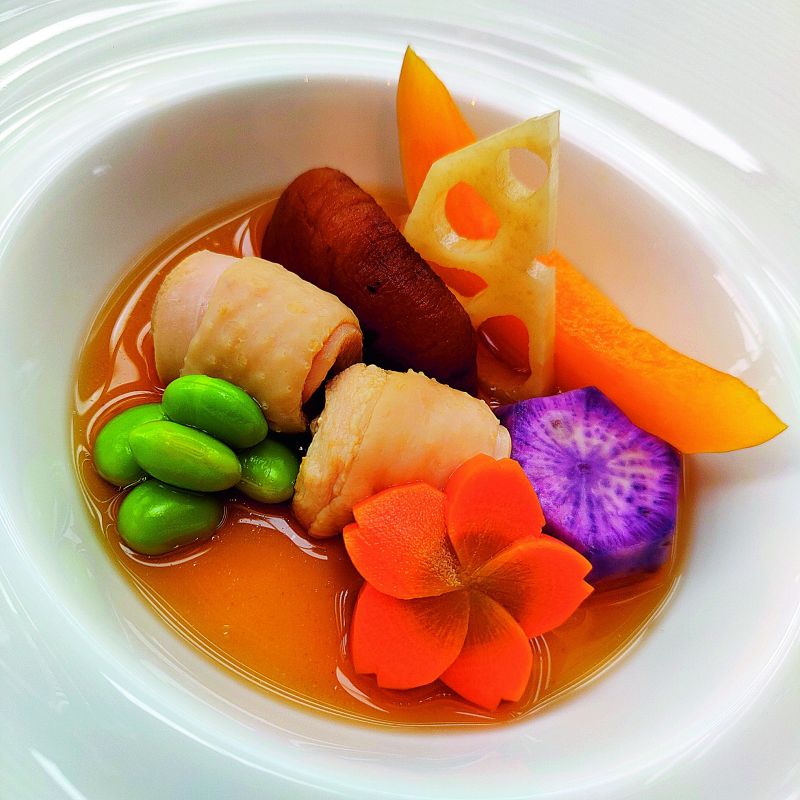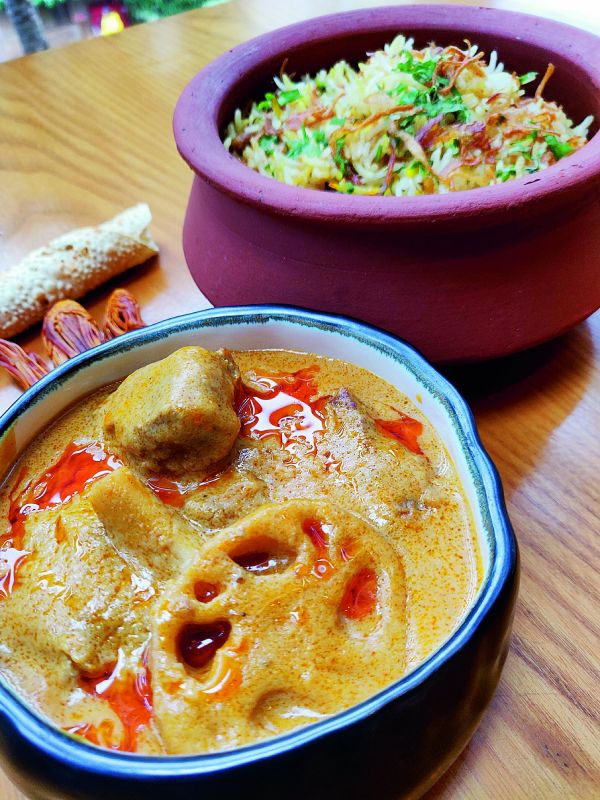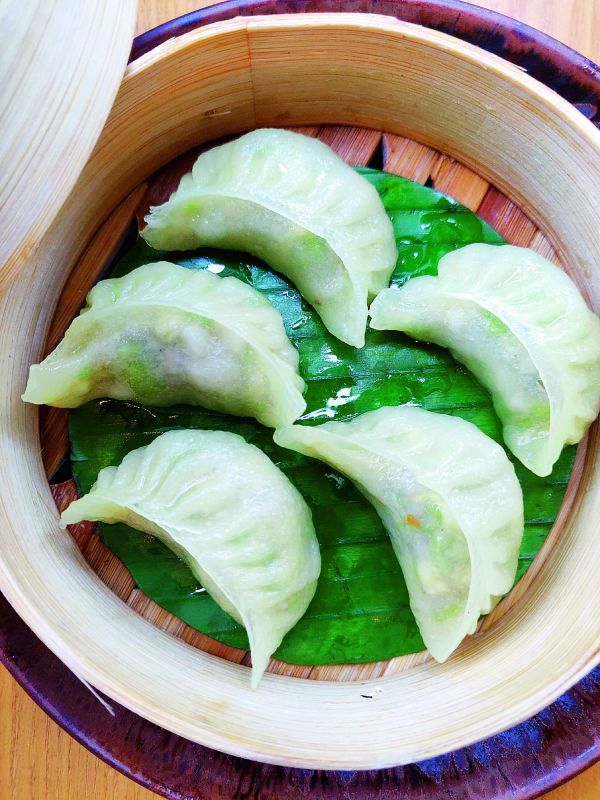In love with lotus
An oft forgotten vegetable that lends itself to much more than fried chips says Fareeda Kanga.

The lotus plant is endemic to Indian culture — after all our National Flower springs from it. The stunning vision of outstretched blooms and unusual seedpods perched on massive leaves floating on ponds across Asia is a familiar sight. Often depicted in paintings, this sacred plant has a deep significance in Hindu and Buddhist art and literature. The entire plant is edible, but the root that grows under the water is the most commonly used part in cooking and is especially important in Chinese vegetarian cuisine. If you look closely the lotus root resembles the dial in old rotary phones!
Although known as a root, it’s actually the rhizome of the lotus flower. Lotus roots grow fairly long under water. They are usually cut and sold in shorter bunches and frequently used as a vegetable in Asian cuisines within soups, deep-fried, stir-fried, braised, or cooked in other interesting ways. In India it is known as ‘Kamal Kakri’ and is cooked in the form of sabzi or as fried chips.
SOURCING AND STORAGE LOTUS ROOT
“Look for fresh lotus roots in a well-stocked vegetable mart or with your local subziwala. Nowadays canned varieties are also available but I recommend fresh lotus root over those. They should be firm and light brown. Give the ones with soft spots, cracks, or blemishes a pass.
Store lotus root in the refrigerator wrapped in a damp cloth or paper towels in a plastic bag. They are at their best when very fresh, but can be stored for a couple of weeks.” says Chef Anupam Gulati, Executive Chef, Four Seasons Hotel, Mumbai.
COOKING WITH LOTUS ROOT
Have acidulated water handy before peeling or slicing the vegetable, as it will discolour fast on oxidising.
Scrub fresh ones with a brush and wash under running water. Cut out any small dark spots and scrape the skin off. Discard any “joint” sections where one segment joins another.
Drain and rinse canned lotus root before using.
And if you aren’t planning on cooking immediately, hang them for a while as this has the added benefit of removing any potential bitter aftertaste.
WAYS To COOK LOTUS ROOT:
Fry ‘Em Up — Think everything's better fried? Lotus root is no exception. Turn them into tasty root chips or as tempura. You can also use slices to hold a ground meat or vegetable filling (like a sandwich) and then pan or deep-fry them.
Get Brothy — Lotus root can be poached in dashi broth, and it also works well in soups. Be mindful — the longer lotus root is cooked, the starchier and stickier it gets.
Go Crunchy — Lotus root can be stir-fried or sautéed. Try pickling slices (or smaller immature rootlets) or blanching them to use in a salad.
Also Minced roots can be used in the nadru kebab
Sweeten the Deal — Candy them or stuff them with sweet black rice and serve with honey and Greek yogurt.
NUTRITIONAL BENEFITS OF LOTUS ROOT
Owing to its rich nutritional composition, the lotus root has a wide range of health benefits. Several studies have confirmed that it contains high levels of polyphenolic compounds and possesses several beneficial health properties, such as hypoglycaemic, anti-inflammatory and antioxidant potential. “Lotus root was considered to possess a strong astringent herb in traditional Chinese Medicine which helps in treating all kinds of bleeding and haematemesis. It has been reported that lotus root has the activities of hypoglycaemic, antifungal, anti-inflammatory, antipyretic and anti anxiety properties.” says Dr. Siddhant Bhargava Co-Founder, Fitness and Nutritional Scientist, Food Darzee.
A study showed that extracts of lotus rhizome exhibited higher antioxidant activity. A single lotus root has 5.6 grams of dietary fibre enough to provide up to 27 percent of your daily fibre needs, depending on your age and sex.
The fibre in lotus roots makes them more satisfying, so you'll feel fuller after eating relatively few calories. Fibre also keeps your bowel movements regular so it prevents constipation and helps control your blood cholesterol levels, which support heart health.
CRISPY LOTUS ROOT WITH SWEET CHILLI DRESSING (Thai)
Ingredients:
4 Lotus root
2 cloves Garlic
1 inch Ginger
2 tbsp roasted peanuts
4 sprig spring onion
4 fresh red chilies
Cooking oil
For Stir-fry Sauce:
½ tbsp Dark soy sauce
1 tbsp Light soy sauce
1 tbsp Vinegar
2 tsp Red Chilli sauce (Sichuan Sauce)
½ tsp Sugar
1 tsp Sesame (Gingelly) Oil
For water starch
1 tsp Corn flour
2 tsp Water
Salt
Method:
Mix the sauce ingredients in a small bowl along with the water starch ingredients.
Boil the sliced lotus stem in a saucepan with two cups of water and a tablespoon of vinegar so that the lotus stem does not turn brown.
After five minutes of boiling, strain the water and place the lotus stem on a kitchen paper napkin to drain all the moisture.
Next, in a small bowl, add four tablespoons of corn flour and salt and dust it over the boiled lotus stem to coat evenly.
Heat a flat-bottomed pan, drizzle some oil and fry the lotus stems until they become crispy and brown.
Later, heat a wok with oil, add ginger and garlic, sauté for one minute.
Once it turns crispy, you can add the sauce mixture slowly and keep stirring till it turns thick and not lumpy.
Add the crispy lotus stem to the mix. Sprinkle the toasted peanuts, red chilies, and spring onions and stir.
Serve the Sweet and Spicy Shanghai Crispy Lotus Stem along with Dan Dan Noodles for a scrumptious meal.

Ingredients:
8 dried Shiitake mushrooms
8 snow peas
1 block Konnyaku (available in gourmet stores)
1 large carrot
1 bamboo shoot
140 gm lotus root
1 chicken breast
1 Tbsp oil
2 1/2 cups Dashi
4 tbsp sugar
5 tbsp soy sauce
3 tbsp Sake
3 tbsp Mirin
Method
Hydrate dried shiitake mushrooms in water in a medium-sized bowl.
Blanch the snow peas in boiling water or Dashi with a pinch of salt.
Cut Konnyaku into ½" thick pieces, make ½" slit in the middle of the piece, and thread an end through the hole to make it appear like a twisted rope.
Cut carrot into ½" thick rounds, then cut with a flower shaped cookie cutter
In a large pot, add oil and heat at medium heat. When the oil becomes hot, add chicken pieces and cook until brown. Add all vegetables except the shiitake and the snow peas, cook, and stir for a couple of minutes. Then add shiitake and dashi, cover, and cook for 15-20 minutes until vegetables become soft.
Add sugar, soy sauce, sake, and mirin, stir, and cook another 15-20 minutes uncovered.
Remove from heat and let it continue to cook, covered, so the meat and vegetables absorb flavours from the soup. Serve with snow peas as garnish.

KASHMIRI NADRU GHOST CURRY (Indian)
Ingredients:
1 lotus stem (scrape and cut diagonally into 8-10 pieces)
400 gm lamb
1/2 cup yogurt
2 black cardamom
1” piece cinnamon stick
1/4 tsp fennel powder
1/4 tsp ginger powder
1/4 tsp cardamom powder
1/8 tsp mint powder
2 tbsp brown onion paste
1 pinch asafoetida
Salt to taste
2 tbsp ghee
Method:
Heat one tablespoon ghee in a pan. Add the black cardamom and cinnamon stick.
When a nice aroma wafts from the spices, add the onion paste.
Sauté it a little and tip in the lotus stem pieces along with the lamb meats.
Add one cup water and a little salt. Simmer until the lotus stems are cooked.
Now in a different pan, heat the remaining ghee and add the spice powders and powdered mint.
Whisk the yogurt and add to the pan. Continue to mix with a spatula to avoid curdling.
Mix this into the cooked lamb meats and lotus stem and simmer.

LOTUS ROOT AND ASPARAGUS DUMPLINGS (DIMSUMS)
Ingredients:
For the Dough
3/4 cup Wheat Starch
2 tbsp Tapioca Starch
¼ tsp Salt
½ cup, plus 2 tablespoons water (boiling)
2 1/2 teaspoons vegetable oil
For the Filling
170 gm lotus root
115 gm green asparagus
1 ½ tsp green onion
3/4 tsp Chinese rice wine
¼ tsp sesame oil
¼ tsp salt
1/8 tsp white pepper
1 large egg white
2 tsp cornstarch
Dough Recipe:
In a medium bowl, combine the wheat starch, tapioca starch, and the salt.
Slowly stir in 1/2 cup of the boiling water. Add the oil and using your hands start shaping the dough.
Add the remaining two tablespoons of boiling water if the dough is too dry. Do not overwork the dough, but continue shaping it for about two minutes, until it is smooth and shiny.
Cover and let rest for 20 minutes.
Make the Filling:
Place the lotus root and asparagus in a medium bowl and add the green onion, rice wine, sesame oil, salt, pepper, egg white, and cornstarch. Mix well.
Cover and refrigerate for an hour to give the flavours a chance to blend.
Form the Dumplings:
Coat a paper towel with vegetable oil and use it to smoothen your cutting board or work surface and the broad side of a cutting knife or cleaver (a cleaver works best). Keep the dough covered to prevent it drying out while preparing the dumplings.
Break off one teaspoon of the dough and roll into a ball. Flatten it by pressing it in the palm of your hand.
Lay the dough on the oiled work surface and press down on it with the oiled side of the knife or cleaver to form a circle that is 2 ½ to 3 inches wide.
Place a heaped teaspoon of filling in the middle of the wrapper, spreading it out evenly, but not touching the edges.
Carefully lift the top edge of the wrapper and fold it over the filling (you should have a half circle now). Use your thumb and forefinger to form pleats in the dough and pinch the edges closed.
Place the completed dumplings on a plate and cover with a damp cloth to keep them from drying out while preparing the remainder of the dumplings.

